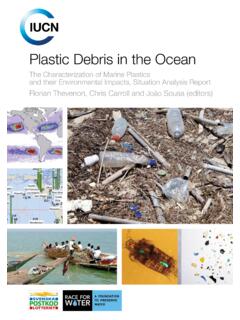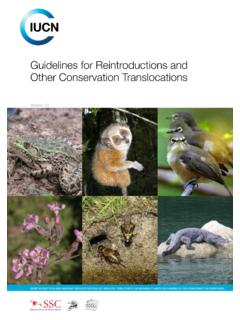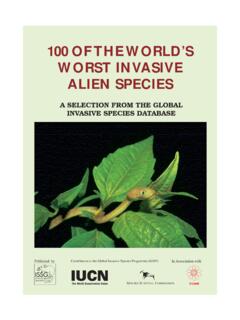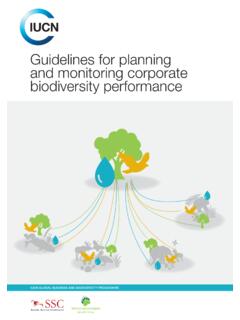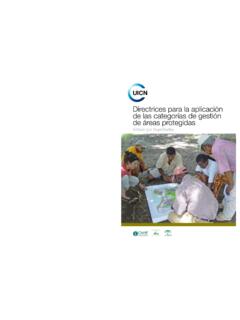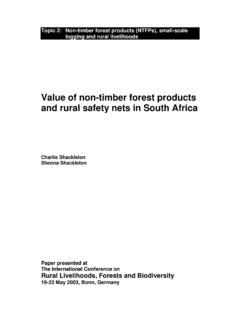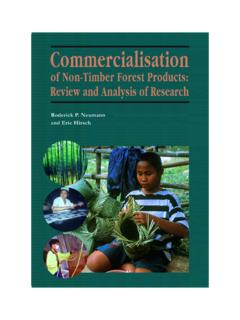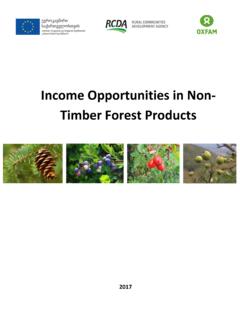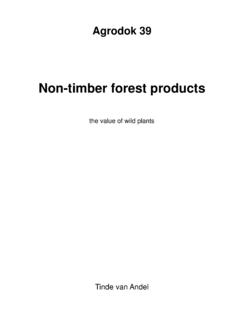Transcription of Non-timber Forest Products - International Union …
1 Non-timber Forest Products :Value, use and management issues in Africa,including examples from Latin AmericaEditors:S. A. Crafter, J. Awimbo, and A. J. BroekhovenIUCN - THE WORLD CONSERVATION UNIONE stablished in 1948, IUCN - The World Conservation Union - is an organisation whose membersinclude governments, non-governmental organisations (NGOs), research institutions and natureconservation agencies in over 130 countries. IUCN's objectives are to promote and encouragethe sustainable conservation of natural Forest CONSERVATION PROGRAMMEIUCN's Forest Conservation Programme coordinates and supports the activities of IUCN secretariat and members working with Forest ecosystems, as well as research and promotion ofthe sustainable use of Forest resources. The World Conservation Monitoring Centre (WCMC)supplies information on animals and plants species, and on habits which are especially importantfor the conservation of biological diversity and the Forest programme includes a study of Forest policy, and field projects relating to specific problemsarising with the management of biologically most important Forest resources.
2 The principles ofthe World Conservation Strategy applied in these projects, which combine the needs ofconservation and those of local populations. Special emphasis is placed on setting up bufferzones around national parks and 's policy and activities are based on information supplied by its members or originatingfrom field projects, and on the analysis of current rends prepared by WCMC. The programmeis developed in consultation with International cooperation organisations, in order to ensurefull consistency between development projects and conservation publications contribute with information and technical recommendations of governments, International institutions, persons responsible for preparing development plans and conservationspecialists. The Forest Conservation Programme's principal financial backer is the Governmentof the EUROPEAN UNIONThe European Union is comprised of 15 Member States, united in an effort to safeguard peaceand promote economic and social progress, and incorporates three communities that havecommon institutions.
3 The Coal and Steel Community was the first to be set up (by the treaty ofParis 1951), followed by an Economic Community and the Atomic Energy Community (treatiesof Rome, 1957).Under the single European Act (1986), the communities finally dismantled all internal bordersto establish a single market. The treaty on European Union , signed in Maastricht in 1992,created a European Union combining a community moving towards economic and monetaryunion, with intergovernmental cooperation in certain areas. The Union is managed by theseinstitutions: a democratically elected parliament, council representing the member states andcomposed of government ministers, a European Council of state or government, a commissionwhich acts as guardian of the treaties and has power to initiate and implement legislation, acourt of justice which ensures that community law is observed and court of auditors whichmonitors the financial management of the Union .
4 In addition, there are a number of advisorybodies which represent economic, social and regional 15 Member States of the European Union are Austria, Ireland, Belgium, Italy, Denmark,Luxembourg, Germany, the Netherlands, Greece, Portugal, Spain, Sweden, Finland, the UnitedKingdom and Forest Conservation ProgrammeNon- timber Forest Products :Value, use and management issues in Africa,including examples from Latin AmericaEditors:S. A. Crafter, J. Awimbo, and A. J. BroekhovenIUCN-The World Conservation UnionEuropean Union1997 Published by:IUCN, Eastern Africa Regional Office, Nairobi. Kenyain collaboration with the European :Citation:(1997) International Union for Conservation of Natureand Natural of this publication for educational or othernon-commercial purposes is authorised without priorwritten permission from the copyright of this publication for resale or othercommercial purposes is prohibited without prior writtenpermission of the copyright S.
5 A., Awimbo. J. and Broekhoven. A. J. Forest Products : value, use and managementissues in Africa, including examples from Latin of a workshop held in Nam Moru, Kenya,8 13 May, 1994. pp. Printers, Nairobi, KenyaJacaranda Designs Limited, Nairobi, KenyaJames ButlerPhoto Caption: Pluteus sp., Arabuko Sokoke ForestDr. Jeff OderaIUCN Communications and Corporate RelationsDivision Rue Mauverney 28, CH-1196, Eastern African Regional OfficeP. O. Box 68200, Nairobi, KenyaThe presentation of material in this document and the geographical designations employed do notimply expression of any opinion whatsoever on the part of IUCN or other participating organisationsconcerning the legal status of any country, territory or area, or concerning the delimitation of itsfrontiers and views expressed in this publication do not necessarily reflect those of IUCN or other :Printed by:Design and typesetting:Cover design:Cover photo:Available from:The text of this book is printed in Times and DISCUSSION GROUPSO verview from the workshopsII.
6 CASE STUDIES: AFRICAV aluing household use of Non-timber Forest productsL. EmertonCAMPFIRE as a model for community-based resourcemanagement: a Zimbabwean perspectiveC. ChinhoyiThe role of Non-timber Forest Products in parts of IringaRegion, TanzaniaR. MinjaAssessment of grass, honey and edible caterpillars insome Forest reserves in MalawiS. D. MakungwaUtilisation of Non-timber Forest Products from Mount ElgonNational Park, Sacred Grove (Kaya Chitsanze), KenyaM. Ndau and W. R. Q. LukeHousehold use of honey and wild meat around Mau Complexand Arabuko-Sokoke Forest ReservesH. MogakaAssessing the patterns of use of Forest resources by localcommunities: field experience in and around Bwindi(Impenetrable) National Park in Southwest Mutebi13151723293741515761 Economic value and role of Non-timber Forest Products in thelong-term management of Forest resources in C te d' IvoireLeonie BonnehinThe use of Non-timber Forest Products in BeninP.
7 HoungnonManagement of Forest reserves and forested national parks inKenya: a role for the use of Non-timber Forest productsG. N. Gathaara and C. D. Kahuki677581 Extractive reserves in Brazil: searching for sustainabledevelopment with social justiceM. Von productive use of the tropical Forest of Guatemala asa strategy for its conservationM. A. P. MendezUse of Non-timber Forest Products for rural sustainable developmentin Central America: the experience of the Olafo ProjectA. C. ImbachNon- timber Forest Products in Latin America: an overviewM. Ruiz Perez9197101113 III. CASE STUDIES: LATIN AMERICA89IV. COUNTRY OVERVIEWS119 BeninBostwanaCamerounCongoC te d' IvoireGabonGhanaKenyaMalawiMo ambiqueSouth AfricaTanzaniaUgandaZaireZimbabweList of participants1211241271301321351371411451 48151153156159161164 INTRODUCTIONG uido BroekhovenCoordinator, Forest Conservation Activities,IUCN Eastern Africa Regional Office, P.
8 O. Box 68200, Nairobi, and management of Non-timber Forest Products (NTFPs) has often been over-looked in strategies and programmes for Forest conservation and management. In Octo-ber 1992, two seminars were jointly organised by IUCN and the Commission of theEuropean Union in Amacayacu (Columbia) and Manaus (Brazil) to assess the situationof extractivism and extractive reserves in Latin America (Ruiz Perez et al, 1993; MurrietaRuiz and Rueda Pinz n, 1995).The success of the two workshops in South America encouraged IUCN and the Com-mission of the European Union , with additional financial support of the CommonwealthScience Council and the Government of France, to organise a third workshop to analysethe situation and to explore the viability of extraction of NTFPs in Africa. Between 8 to13 May 1994 a pan-African workshop on NTFPs was organised by IUCN and held inNaro Moru, Kenya.
9 This workshop was one of various initiatives undertaken by IUCNto improve knowledge and understanding of the role and potential of NTFPs in workshops are part of a larger programme as various field-based projects arecurrently being implemented or developed in, amongst others, Latin America, Laos,Philippines and Uganda, to test and gain experience with NTFPs in Forest conservationstrategies. In southeast Asia, IUCN is involved in a network on NTFPs and in EasternAfrica a recent workshop was jointly organised with CIFOR to assess research priori-ties for workshop in Naro MoruThe aim of the workshop was to provide a forum for individuals and institutions work-ing on NTFPs to exchange information and experience and to analyse the (potential)role of NTFPs in Forest management and conservation strategies. The meeting was at-tended by 43 people from 14 (francophone and anglophone) African countries and 4 Latin American countries.
10 Participants included representatives of research institutions, Forest departments, field projects, NGOs and International Forest ProductsNon- timber Forest productsNon- timber Forest Products have been defined in different ways by different Beer and McDermott (1989) emphasise the physical properties of the product anddefine NTFPs as "all biological materials other than timber , fuelwood and carbon, whichare extracted from natural Forest for human use". In the definition by Falconer (1990),emphasis is on the extraction of Forest Products by local people for home consumptionand for sale, to be distinguished from large-scale extraction for timber and pulp. Shedefines NTFPs as "those Forest Products , include by- Products such as bushmeat andmushrooms, that are not processed by large industries". Both definitions are useful be-cause they capture different aspects of NTFPs.

